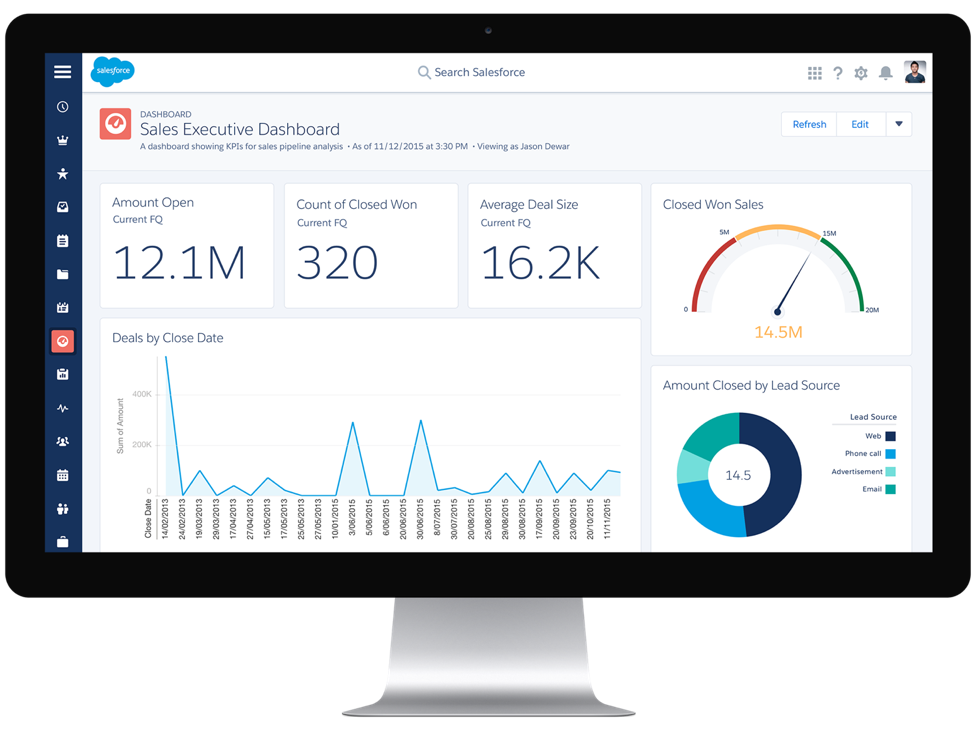
The time has arrived. You need customer relationship management (CRM) software to meet the demands of your growing business.
We know there are a million other decisions that are easier to make—and to be blunt, more enjoyable. There are many CRM options, all of which are a huge financial commitment. Transitioning to a new CRM can either pay off or seriously cost you.

But fear not. We tested two of the biggest names in the CRM game to see how they work—or don’t work—so you don’t have to.
When people think CRM software, they think Salesforce. As the long-standing leader in the CRM software space, Salesforce’s name is everywhere. This shouldn’t come as too much of shock as they own around 40% of the CRM market. However, in recent years, competition has been creeping up. It turns out that the most popular CRM may not be the best for every business, and there are a number of other options out there that may better fit your needs.
One of our favorites? HubSpot CRM. As soon as it emerged in 2014, it quickly became a favorite among businesses looking to organize, track, and nurture leads and customers.
So that leaves us to wonder— is Salesforce doomed to be canceled or does HubSpot seem too good to be true?

Let’s take a closer look:
Pricing
Time to address the expensive elephant in the room. The one glaring difference is the licensing cost between HubSpot and Salesforce. The HubSpot CRM is absolutely, 100% free (yes, you read that right). If you want to take your CRM to the next level with a range of marketing, sales, and service features, that’s also an option—for a price. On the other hand, Salesforce is only free as a 30-Day Trial.
Let’s break down the Salesforce cost after the free 30 days:
Salesforce Pricing Breakdown
Salesforce costs $25-$300 per month for each user. These pricing levels can fluctuate depending on what you need from your CRM. If you’re looking for a simple way to manage your leads and customers, you’ll be in the $25 range. If you want more advanced capabilities like sales forecasts, quoting/billing options, and automation, you can expect to be closer to $300 territory.
Let’s say you need 20 Salesforce users with a range of capabilities. If you break out the licensing tiers among your team, this is what you can expect to pay:
- 5 Professional Licenses ($75 each)
- 14 Enterprise Licenses ($150 each)
- 1 Unlimited License ($300 each)
Total Monthly Salesforce Cost for 20 Users: $2,775
Not too bad, right? Well, consider this: Salesforce bills annually. If we’re talking about your annual budget, here’s what you’re really be paying:
$2,775 x 12 months = $33,300 paid annually
If you feel like you’ll need a little help down the road and want to access Customer Support, you’ll need to pay extra. With a support path from Salesforce (Premier, Premier+ or Signature), licensing 20-30% more or even higher. These packages provide access to the following support features:
1. Webinars
2. 24/7 Phone Support
3. Chat Support
4. 1-Hour or 15-Minute Critical Issue Response
5. Success Engineers
6. Customized Training Plans
So, how much does Salesforce actually cost?
In this case, if you decide to make 20 members of your team users and opt for the Premier support path, you’re going to pay 20% more for Salesforce, they may be paying 20% more for Salesforce.
Your final cost: $3,330 per month, paid upfront annually as $39,960.
HubSpot’s CRM Pricing Breakdown
HubSpot CRM Free Hub is just that: Free. Forever.

I know it’s a bit hard to believe, so let me say it again: The HubSpot customer relationship management software and its features are now and forever free to all users.
For the cost of $0, a subscription provides you with storage for up to 1 million contacts, 1 million users, and no storage expiration date. Not too shabby for paying nada.
The Free HubSpot CRM allows users to generate website leads and track contact activity , as well as a range of other features:
- Forms
- Contact Management
- Contact and Company Insights
- Ad Management
- Conversations Inbox
- Live Chat
- Conversational Bots
- Reporting Dashboards
HubSpot CRM Hub total cost: $0
Though HubSpot’s CRM Free Hub is great, there are several more advanced packages and paid add-on tools that do require upfront annual payments.
WINNER: HubSpot, hands down. For a free option, its CRM features are extensive.
User Friendliness
The users speak for themselves on this matter. Data from multiple sources reports the following for customer satisfaction scores:
- Salesforce received an average of 4.07/5 for customer satisfaction
- HubSpot CRM received an average of 4.4/5 for customer satisfaction
WINNER: HubSpot. (Full transparency: We /are/ a Certified HubSpot Agency Partner, so we’d arguably give it a 5, but we figured we’d keep things objective.)
Features
It would be an understatement to say Salesforce has a lot of features. Salesforce is LOADED to the brim with features… an overwhelming amount, if I’m being honest.
There are 20 common features associated with most CRM technologies. Data, compiled from around 6,000 users, looks at how HubSpot and Salesforce stack up against one another with common tools:
HubSpot
Salesforce
Opportunity & Pipeline Management
✅
✅
Reporting & Dashboards
✅
✅
Social Collaboration
✅
✅
Mobile App
✅
✅
User Role & Access Management
✅
✅
Customization
✅ (limited)
✅
Workflow Capacity Monitoring
✅
✅
Integration APIs
✅
✅
Data Import & Export
✅
✅
Customer Contract Management
❌
✅
Product & Pricing Management
❌
✅
Quote & Order Management
❌
✅
Forecasting
❌
✅
Sandbox/Test Development Environments
❌
✅
Internationalization
❌
✅
Territory Management
❌
✅
Task Management
✅
❌
Desktop Integration
✅
❌
Output Document Generation
✅
❌
Document & Content Management
✅
❌
WINNER: Salesforce. Though HubSpot, for a free CRM tool, is still quite the deal, containing 13/20 of the common CRM tools. (If we’re talking about HubSpot’s paid options, that’s a totally different story.)
Interface
Salesforce is like an amusement park—so many wondrous things to do with so little time. Their interface reflects just that. The end result is an overwhelming UI with too many tabs and icons that make for a cluttered and confusing navigation bar.

On the flip side, HubSpot has a very simplified and clear navigation with dropdown menus to help your CRM navigation. Sleek, simple, and most importantly, efficient.
WINNER: HubSpot. We aren’t about the chase when it’s time to get down to business on a CRM, especially when paying THAT much annually. Sorry, not sorry, Salesforce.
Integrations
The size of the integration ecosystem a CRM provides can be very important when considering a management software for your business. Depending on the size of your company, you may depend heavily on having access to many integrations, or you may just need access to more commonly used integrations.
HubSpot offers 11 internally supported integrations, including: Salesforce (Oh, the irony: the two can actually complement each other very well… if you have the budget to implement both), Zapier, Google Calendar, Chrome, and Wistia. HubSpot is consistently expanding their list and their open API allows companies the option to build custom integrations for their business.
Salesforce has an ecosystem comprised of thousands of integrations and products that can be access in their App Exchange. This large ecosystem is beneficial to large corporations that utilize many integrations for their daily operations.
WINNER: Salesforce, due to their plethora of integration options.
Emailing Features
You’ve got mail…tracking. Sorry Tom Hanks but having a CRM that syncs with your email is essential for optimizing business productivity.

Both HubSpot and Salesforce include the following email features:
- Calendar Scheduling Integration
- Email Open Tracking
- Email Click Tracking
- Email Templates
- Document Tracking
- CRM Insights
Though both CRMs share many of the same emailing capabilities, there is one that sets HubSpot apart: Email Sequences.
Email Sequences allow a business to automate their email efforts by enrolling prospects in a series of timed emails. It allows businesses to tailor and personalize their outreach times depending on the targeted prospects. You can enroll prospects in sequences right from your inbox.
WINNER: HubSpot, marketing automation can save businesses so much time while making their sales outreach significantly broader and more efficient.
So, which CRM is best for you and your company?
Salesforce costs significantly more than the HubSpot Free CRM. As a result, Salesforce has a tremendous amount of capabilities, but that doesn’t necessarily mean those features will best serve your brand. HubSpot, though limited, is a free option that is loaded with all the essential CRM functionalities vital for business productivity.

HubSpot’s Free CRM is a premier choice for small to mid-sized business that need a top-notch CRM that won’t cost them a top-dollar price.
We like you—and we really, really like HubSpot—so if it were up to us, we’d recommend you opt for HubSpot’s Free CRM to start. If you’re interested in getting started with HubSpot and making your CRM work best for your business, we can help.
{{cta(‘7924dfeb-e451-4a77-a594-d82f6bdd3ccb’)}}